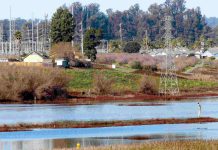WATSONVILLE — The Watsonville City Council on Tuesday directed City of Watsonville staff to prepare a final draft of a Master Plan for the City Plaza.
The roughly $3.36 million proposed plan would give all of the Plaza’s historical elements a refurbishing while also adding a permanent stage and dedicated picnic and game table areas.
City staff will now finalize the plan and prepare an application that will be submitted to state officials in hopes of qualifying for Prop 68 funds. The deadline for the first round of funding from the voter-approved $4.1 billion bond measure, according to Watsonville Director of Parks and Community Services Nick Calubaquib, is Aug. 3.
There is no guarantee the state will select Watsonville for funding, but Calubaquib said the city has a very good chance of making the cut.
“I think what we’ve heard from our state legislatures is that Watsonville is well positioned for Prop 68 funding in terms of demographics and overall need,” Calubaquib said. “This grant will definitely be very, very competitive, but the other piece to this is that without these type of plans in place, it’s very difficult to even be in the running for these types of grant opportunities in the first place.”
Verde Design, Inc. presented three different designs to the City Council, and the latter took pieces from all three and melded them into a final plan, which removed two of the Parks and Recreation Commission’s suggestions from last week’s meeting: a terraced seating on the Main Street side of the Plaza and a small play area for kids off Union Street.
The decision to move forward with the plan did not come without pushback from the community.
Pajaro Valley Historical Association President Judy Doering Nielsen said the organization did not support any changes to the Plaza, which holds a spot in the National Registry of Historic Places for its historic significance in architecture/engineering.
A petition protesting changes to the Plaza has also received more than 450 signatures in two weeks, according to Nielsen, who added that the Slavic American Cultural Organization and Sons and Daughters of Italy have also said they are adamantly against any changes.
“If you want to maintain a historic presence in the town of Watsonville, then for heaven’s sakes do not take on these structures,” Nielsen said.
Community activist Alex Solano said the original deed holder, Don Sebastian Rodriguez, donated the land to the city with the idea that it would be solely used as a public town plaza — not a performance hub.
“It was meant for the public,” Solano said. “Leave it alone, please.”

The Watsonville City Council selected this conceptual design without the small play area (8) and sloped lawn (5). — Courtesy of City of Watsonville
Nielsen and Solano joined about a half dozen others who also voiced concerns about the changes to the Plaza, but other members of the community saw the changes as a positive.
Maria Elena De La Garza, who said she was a longtime resident, said the events the city has conducted in the Plaza over the last few years has helped bring the community together, and that she’d like to see more of them in the near future.
“[The events have] created a sense of community for our town that I have not seen in a really, really, really long time,” De La Garza said.
De La Garza, however, did also voice concern about modifications to the Plaza’s historic monuments such as the gazebo, water fountain, cannons and several trees that were planted for various reasons.
Multiple councilmembers reassured the public that all of those aspects of the Plaza would stay intact or be renovated to be preserved for future generations.
“I want people to know all the historical monuments are going to stay. We’re not getting rid of any of those monuments,” Councilman Aurelio Gonzalez said. “The cannons are dear to me. The water fountain is dear to me. The gazebo is dear to me. We all understand that, but what we also have to understand is that our city is growing and we need to be able to go with the change to our city.”
The council was also supposed to make a decision on proposed changes to Ramsay Park, but ran out of time during its early session.
The creation of a master plan for both parks is part of department’s push to update its overarching Parks and Recreation Master Plan, which was first developed in 2009.
That plan, however, was never realized for several reasons — the recession being the biggest — so the department decided to revisit the program this year and make adjustments according to the current direction of the city, which earlier this year walked back its strict alcohol ordinance put in place in 2002 and is in the process of developing a Complete Streets Plan for the downtown.
The most recent Complete Street Plan proposal — presented to the City Council in early May — would make drastic changes to the structure of downtown, including the slimming of the oft-congested Main Street from four lanes to two and the addition of wider sidewalks, high-visibility crosswalks and buffered bike lanes.
City officials hope the changes to the Plaza will help turn it into a community hub for all ages, Watsonville Mayor Francisco Estrada said.
“That’s really the purpose of a Plaza, I think: A center point for the community to come together,” Estrada said. “I think we can do all these things. I think we can honor our history. I think we can preserve our history. And we can leave our stamp for future generations.”













